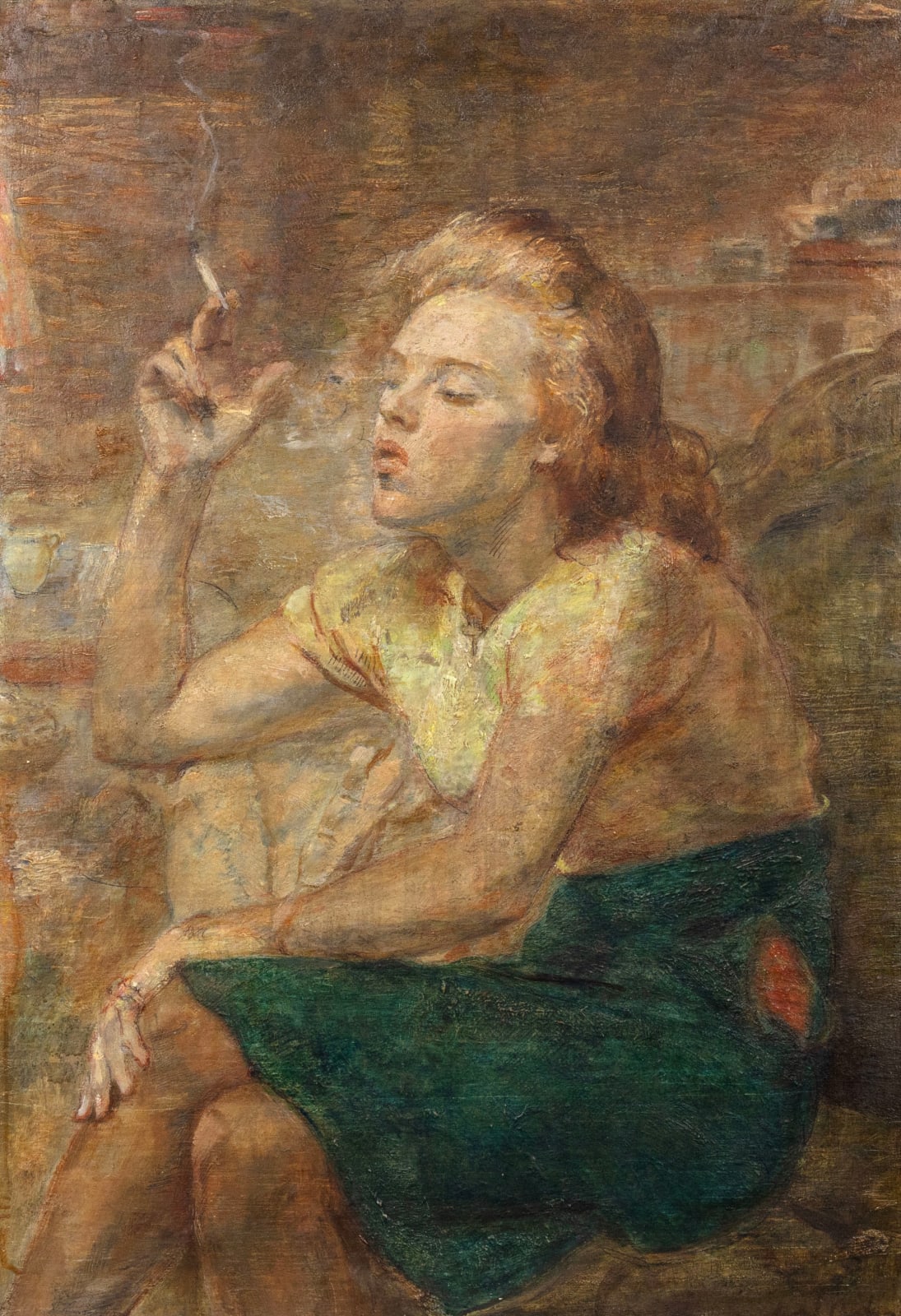-
Artworks
Isabel Bishop
Blowing Smoke Rings, 1938Oil on panel20⅛ x 14⅛ inches
51.1 x 35.9 cmSigned at lower right: Isabel BishopSoldFurther images
Perhaps surprisingly, Isabel Bishop once explained that it was Jane Austen who most closely matched her own artistic aims over fifty years of practice—near the end of her career, Bishop...Perhaps surprisingly, Isabel Bishop once explained that it was Jane Austen who most closely matched her own artistic aims over fifty years of practice—near the end of her career, Bishop undertook illustrating Austen’s Pride and Prejudice, a task that reinforced her affinity with Austen’s novels about young women in Regency England. Austen, she said, sketches in only what she believes is important about a portrayal and yet convinces the reader that the picture is utterly complete: “She doesn’t describe, in detail, environments; while she gives you the immediate social context of individual characters, she is silent about the wider context—you don’t know the general economic situation, or that England was at war.” [1] Such was Bishop’s “social realism” centered wholly on the study of the enigmatic modern woman—no lecturing.
There was not necessarily an explicit social program that she assigned to the catalogue of women she eventually built, either, she said. There was serendipity to the subjects that caught her attention. She painted the girls who came and went from the office buildings, shops, and cafés around her studio in Union Square because they were suddenly there, she explained; they moved in and out of her frame of vision as spirits to which she gave form.
Blowing Smoke Rings possesses that ethereal quality that characterizes all of Bishop’s work. The face and figure of the young woman seem to emerge slowly out of a haze. It takes a while to collect the visual data. Eventually we see the split zipper or torn seam in the girl’s skirt, a poignant detail.
The thin veils of light, transparent color, soft contours, and delicate cross-hatching never betray the fact that Bishop’s gossamer web of a painting was rather laboriously constructed. She painted slowly, beginning often with sketches, drawings, and even etchings and aquatints, which were often essential steps to painting. Etching enabled her to see a composition clearly in terms of line, while aquatint offered chance effects of light, shade, and tone.
When she extracted an image out of her studies and set about to paint, the process of pulling form and mood out of the surface of the panel was itself a process of discovery. Having thoroughly prepared her panels with eight coats of gesso, she established a ground of random horizontal gray stripes using gelatin, powdered charcoal, and white lead—a technique used by Peter Paul Rubens. Bishop was a dedicated student of the Old Masters. She next drew in her subject with pencil, ink, or tempera, then applied thin layers of varnish across the field so as to create luminosity. Using a limited palette of flesh tones and—in the case of Blowing Smoke Rings, cool blue, silvery white, and steely gray—she dabbed color atop this tacky surface. In places she knit together forms with fine tempera strokes. [2] The overall impression is of a figure once observed and filtered through the memory. It is a distillation, as Bishop would have it, of the particularities that defined for her not an era and not a place, but a singularly haunting moment.
— Patricia Junker
[1] Bishop, in the afterword to her illustrated edition of Pride and Prejudice, published 1974; quoted in Helen Yglesias, Isabel Bishop (Chesterfield, MA: Chameleon Books, 1989), 23.
[2] A thorough discussion of Bishop’s practice is laid out by Yglesias, 17–18.
Provenance
The artist;
[Midtown Galleries, New York];
Mrs. Jean Howard, Beverly Hills, California;
[ACA Galleries, New York];
Private collection, New York;
[ACA Galleries, New York];
[Guggenheim Asher Associates, 1996]; to
The present owner
Exhibitions
Laband Art Gallery, Loyola Marymount University, Los Angeles, Isabel Bishop: The Affectionate Eye: Paintings, Drawings, Etching and Aquatints, 1925-1982, February 9–March 16, 1985, no. 22
National Museum of Women in the Arts, Washington, D.C., Isabel Bishop, July 24–September 9, 1990
Schoelkopf Gallery, New York, American Stories: The Kathleen Kennedy and Frank Marshall Collection, January 17—February 28, 2025
Literature
Bruce St. John, Isabel Bishop, The Affectionate Eye: Paintings, Drawings, Etchings, and Aquatints, 1925-1982, Los Angeles: Laband Art Gallery, Loyola Marymount University, 1985, no. 22, p. 44, illus. p. 45
Helen Yglesias, Isabel Bishop, New York: Rizzoli, 1989, p. 21, illus. p. 90
Claire Ittner, Patricia Junker, and Carol Troyen, American Stories: The Kathleen Kennedy and Frank Marshall Collection, New York: Schoelkopf Gallery, 20251of 2
Subscribe to our mailing list to receive updates from the gallery
* denotes required fields
We will process the personal data you have supplied in accordance with our privacy policy (available on request). You can unsubscribe or change your preferences at any time by clicking the link in our emails.


